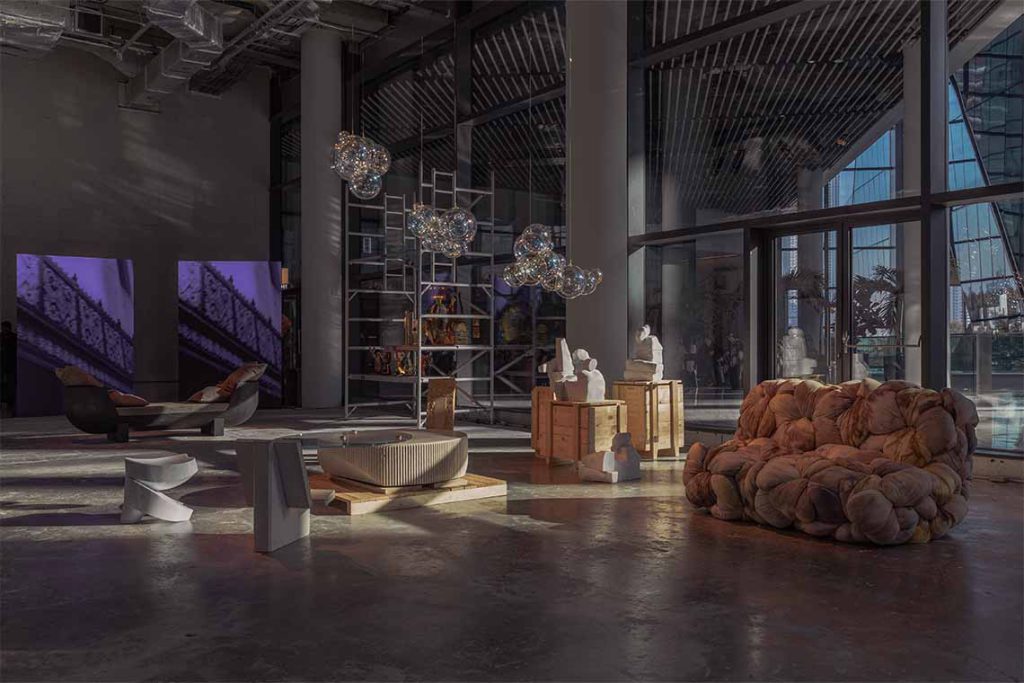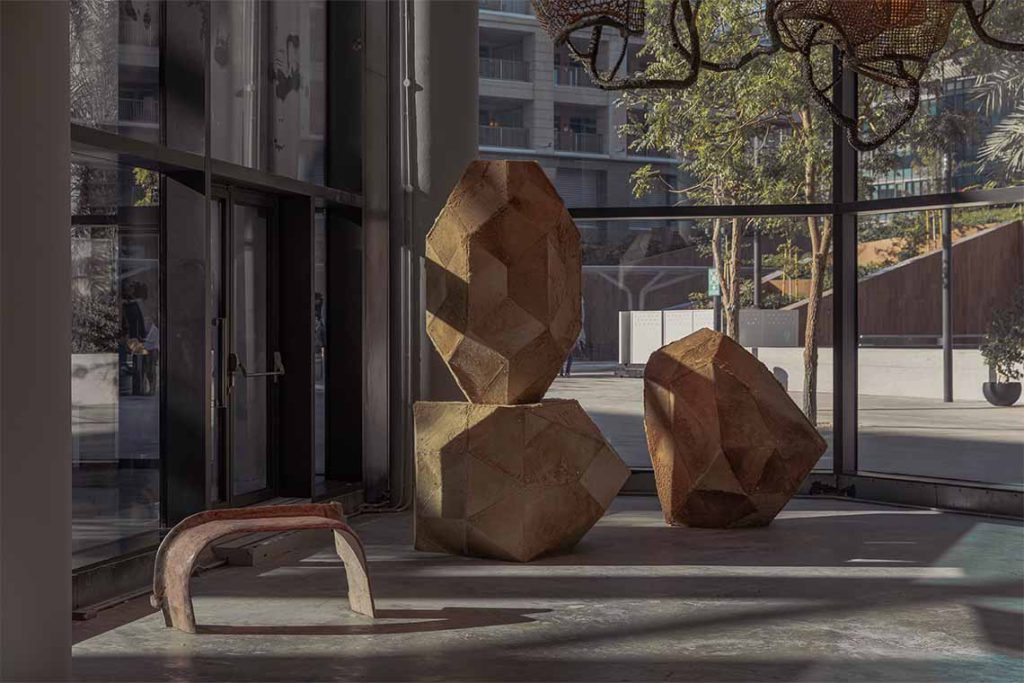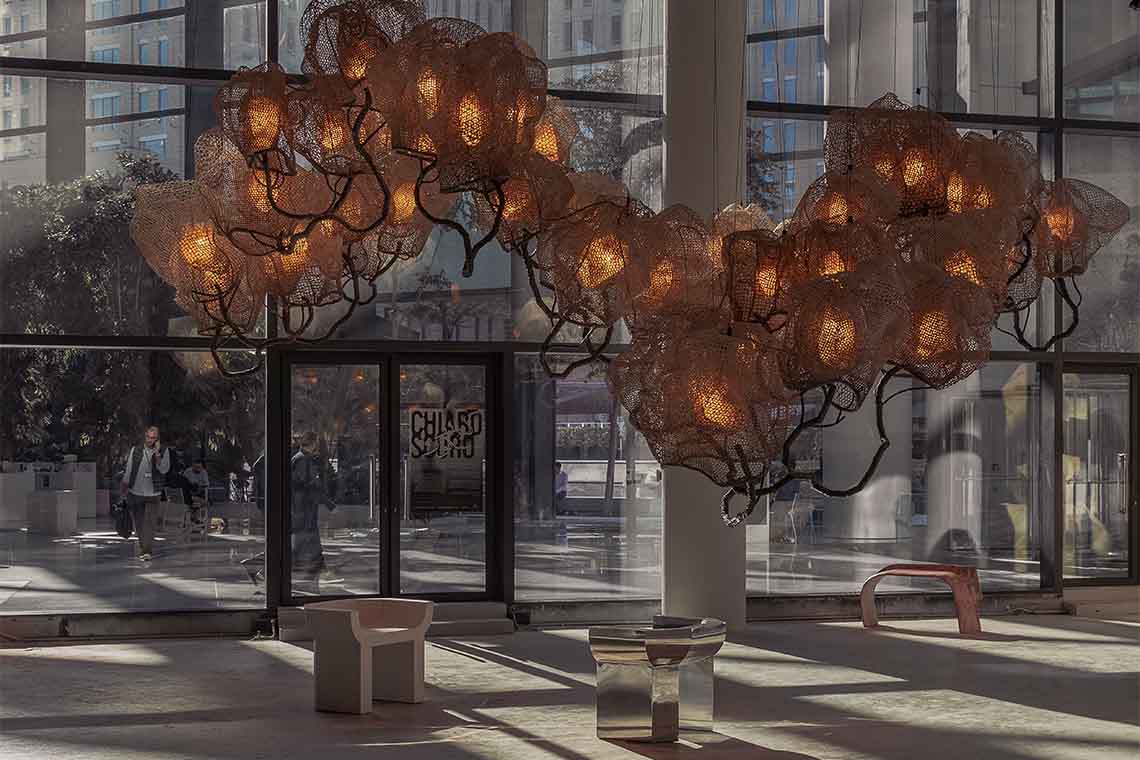Featuring 22 artists and designers, Chiaroscuro at ICD Brookfield Place reflects the duality of night and day, inspired by Dubai’s shifting landscape.
I first visited Chiaroscuro on a rare rainy day in Dubai. Peering out through the glass facade of ICD Brookfield Place, there was nothing but grey. Neighbouring the busy main atrium, which was full of workers sheltering from the rain, an invitingly warm glow radiated from the building’s public exhibition and events space. The next day, as the skies cleared and the sun beat down on DIFC, new dimensions of that warm, light-filled corner came to the fore: shadow, duskiness and a palpable broodiness were at play, offering respite from the harsh sunlight.
Should multiple visits not be an option, though, no matter when you step into Chiaroscuro, such a tension – between light and dark, night and day – is unmistakable. Curated by the inimitable French fashion legend (as well as furniture designer, performer, and restaurateur) Michèle Lamy, and presented in collaboration with ICD Brookfield Place Arts and design-art leaders Carpenters Workshop Gallery, the exhibition of 22 artists and designers is a tale of two halves. Taking inspiration from Dubai’s landscape as it transitions from day to night, Lamy has divided the exhibition between these two distinct states and the liminal space between them.
Two works by Spanish designer Nacho Carbonell encapsulate the duality of Chiaroscuro. “He’s from Valencia, and a lot of his work is inspired by fishermen’s nets,” says Malak Abu-Qaoud, curator of ICD Brookfield Place Arts in the Middle East, of Carbonell’s Inside a Forest Cloud (113/2019) (2019). Stepping beneath this “chandelier”, as Abu-Qaoud describes it, feels akin to taking refuge under the branches of an ethereal tree; rather than offering shade, however, this tree is luminescent, its seemingly innate glow gently breaking through black webbed structures reminiscent of fishing nets or honeycomb. Carbonell’s Combi Cocoon 2 (46/2016) (2016) also blurs the boundaries between the worlds of art, nature and city, with a chair, side table and tree-cum-light growing from a concrete boulder.

Beyond these microcosmic works, viewers are ushered into the mysteries of what Lamy has called “The Darkness”, anchored in the tiger-striped plywood Gallic Chair (2007) by Rick Owens (Lamy’s husband and longtime collaborator), which confounds in its fusion of brutalism and unexpected, playful details. The section’s arresting yet muted colour palette – characterised by rich bronze and brown (in parts nearing black) hues, hinting at hidden depths – is continued in Wendell Castle’s The Light of Darkness (2012), a functional sculpture made of stained ash and whose apparent severe, monochrome character belies the complexity of light and shadow fostered by its curved forms. Patinated bronze works from Kendell Geers’s Flesh of the Spirit (2016–21) series interpret the oft-fetishised idols and masks associated with African cultures, dubbed forms of ‘primitive’ art; integrating novel elements, including an imprint of a hand representing a denial of the right to speak, Geer problematises our perception of African art.
The dialogue continues with “The Light”; if its dark counterpart sought to surprise and unsettle, it is here that, as Lamy described, visitors are able to “reimagine our world… to envision better times”. It is here, also, that local and regional artists particularly make their mark on the show – something Abu Qaoud feels strongly about and which has been key to the programme at ICD Brookfield Place, with past shows including FLOATING WORLD by Kuwaiti artist Monira Al Qadiri and group exhibition Do Arabs Dream of Electric Sheep?, featuring Morocco-born artist Meriem Bennani and Palestinian visual artist and graphic designer Haitham Haddad. “We’re in the UAE, we’re in the Middle East… you need to have regional artists, local artists,” Abu Qaoud tells Canvas.
Among the most notable works in Chiaroscuro, Dubai-born visual artist Latifa Saeed presents a special edition of her near-iconic Braided (2013) furniture series, created in collaboration with fashion studio MĒRU. With the series as a whole – including chairs, sofas and ottomans – inspired by traditional Emirati hair braiding, Saeed reimagines and repurposes a time-honoured creative technique, challenging the idea of ‘heritage’ being something that belongs to the past. Her (extremely comfy) tie-dyed couch designed for Chiaroscuro draws further on the show’s context, with the natural dye created in collaboration with another UAE-based designer.

In her Camouflage 2 (2022), Emirati conceptual artist Zeinab Alhashemi explores the different forces shaping – quite literally – the UAE of the future. Her aluminium sculptures, evoking Dubai’s ultra-modern skyline in their form, are wrapped in camel hide, the securing screw bolts hinting at the possible inextricability of urban development from the landscape and culture on which it stands. Dutch studio DRIFT’s Fragile Future 3.10 (2014) equally combines the organic and the futuristic, by fusing real, delicate dandelion heads to a copper lattice in their beguiling light sculpture. This melding of technology and nature, with light a symbol of hope and life, conveys their continued coexistence and mutual evolution.
Other works by Maarten Baas, Jose Davila, the Campana Brothers and Studio Job draw on icons of pop art and bring a dose of colour to the space, interacting not only with illumination from light art pieces but also screens showing a rotation of video works, including a sand tornado by Saeed. The playfulness of these pop art-inspired pieces is matched in Omar Al Gurg’s functional yet fun modular Spike (2020) sculptures.
As I ask Abu-Qaoud how she feels about ICD Brookfield’s first design show, she is quick to emphasise that while “that’s a big thing”, “it’s not just design…it’s art, design and sculptures. It’s a conversation.” In this respect, Chiaroscuro is emblematic of ICD Brookfield Place Arts and Brookfield arts programmes more broadly, originally developed to create community among building tenants in New York. At the heart lies dialogue: between artworks, between occupants of the building, and between the seemingly disparate worlds of art and business.
Chiaroscuro runs until 15 March 2024



